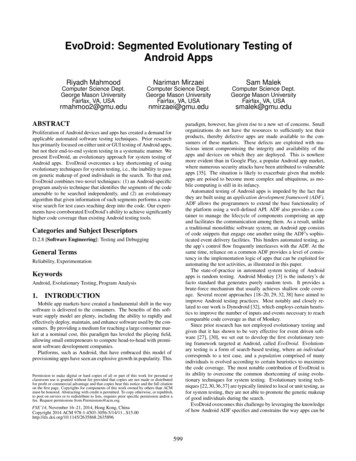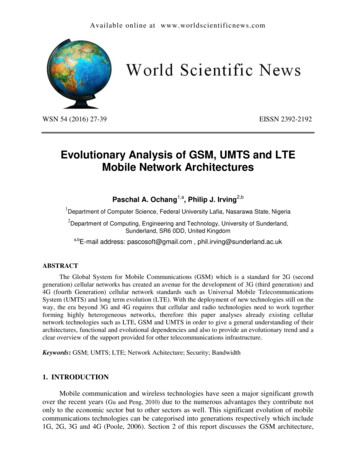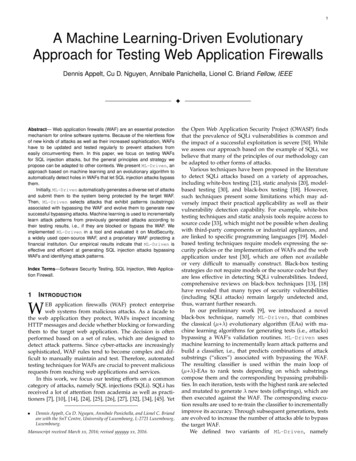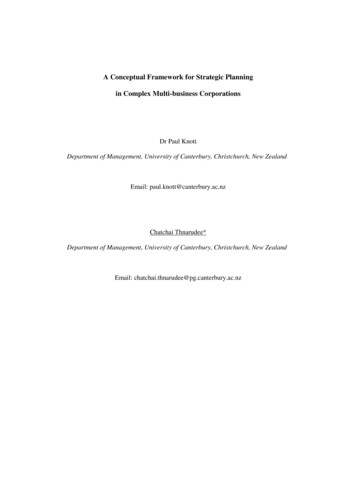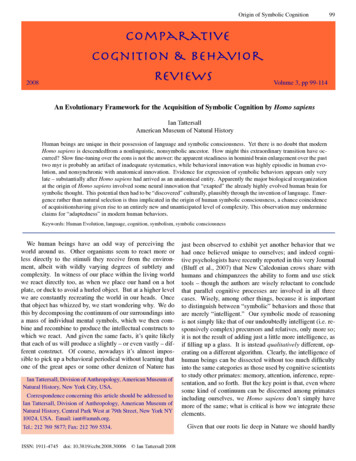
Transcription
Origin of Symbolic Cognition200899Volume 3, pp 99-114An Evolutionary Framework for the Acquisition of Symbolic Cognition by Homo sapiensIan TattersallAmerican Museum of Natural HistoryHuman beings are unique in their possession of language and symbolic consciousness. Yet there is no doubt that modernHomo sapiens is descendedfrom a nonlinguistic, nonsymbolic ancestor. How might this extraordinary transition have occurred? Slow fine-tuning over the eons is not the answer: the apparent steadiness in hominid brain enlargement over the pasttwo myr is probably an artifact of inadequate systematics, while behavioral innovation was highly episodic in human evolution, and nonsynchronic with anatomical innovation. Evidence for expression of symbolic behaviors appears only verylate – substantially after Homo sapiens had arrived as an anatomical entity. Apparently the major biological reorganizationat the origin of Homo sapiens involved some neural innovation that “exapted” the already highly evolved human brain forsymbolic thought. This potential then had to be “discovered” culturally, plausibly through the invention of language. Emergence rather than natural selection is thus implicated in the origin of human symbolic consciousness, a chance coincidenceof acquisitionshaving given rise to an entirely new and unanticipated level of complexity. This observation may undermineclaims for “adaptedness” in modern human behaviors.Keywords: Human Evolution, language, cognition, symbolism, symbolic consciousnessWe human beings have an odd way of perceiving theworld around us. Other organisms seem to react more orless directly to the stimuli they receive from the environment, albeit with wildly varying degrees of subtlety andcomplexity. In witness of our place within the living worldwe react directly too, as when we place our hand on a hotplate, or duck to avoid a hurled object. But at a higher levelwe are constantly recreating the world in our heads. Oncethat object has whizzed by, we start wondering why. We dothis by decomposing the continuum of our surroundings intoa mass of individual mental symbols, which we then combine and recombine to produce the intellectual constructs towhich we react. And given the same facts, it’s quite likelythat each of us will produce a slightly – or even vastly – different construct. Of course, nowadays it’s almost impossible to pick up a behavioral periodical without learning thatone of the great apes or some other denizen of Nature hasIan Tattersall, Division of Anthropology, American Museum ofNatural History, New York City, USA.Correspondence concerning this article should be addressed toIan Tattersall, Division of Anthropology, American Museum ofNatural History, Central Park West at 79th Street, New York NY10024, USA. Email: iant@amnh.org.Tel.: 212 769 5877; Fax: 212 769 5334.ISSN: 1911-4745doi: 10.3819/ccbr.2008.30006 Ian Tattersall 2008just been observed to exhibit yet another behavior that wehad once believed unique to ourselves; and indeed cognitive psychologists have recently reported in this very Journal(Bluff et al., 2007) that New Caledonian crows share withhumans and chimpanzees the ability to form and use sticktools – though the authors are wisely reluctant to concludethat parallel cognitive processes are involved in all threecases. Wisely, among other things, because it is importantto distinguish between “symbolic” behaviors and those thatare merely “intelligent.” Our symbolic mode of reasoningis not simply like that of our undoubtedly intelligent (i.e. responsively complex) precursors and relatives, only more so;it is not the result of adding just a little more intelligence, asif filling up a glass. It is instead qualitatively different, operating on a different algorithm. Clearly, the intelligence ofhuman beings can be dissected without too much difficultyinto the same categories as those used by cognitive scientiststo study other primates: memory, attention, inference, representation, and so forth. But the key point is that, even wheresome kind of continuum can be discerned among primatesincluding ourselves, we Homo sapiens don’t simply havemore of the same; what is critical is how we integrate theseelements.Given that our roots lie deep in Nature we should hardly
Origin of Symbolic Cognitionbe surprised that we share a lot of our makeup with othercreatures, and particularly with our closest relatives. Oneof the great behavioral revelations of recent years has beenthat we share with apes certain aspects of what we recognizeas “culture,” in the sense that some great ape populationsalso show local behavioral traditions that are passed throughthe generations by learning – in one case at least, apparentlyover millennia (Mercader et al., 2007). In a wider sense,however, the vastly varying cultures of modern humans arequalitatively different from anything we see amongst thegreat apes, principally because much of what makes humancultures unique lies in the abstract belief systems on whichthey are based, rather than on simple direct imitation. Andon another cognitive level, what is truly different about human beings is that, based on our symbolic abilities, we havea generalized and apparently inexhaustible capacity for generating new behaviors when presented with new stimuli.Certainly it is our symbolic cognition, rather than any ofour many physical peculiarities, that gives us our very strongsense of apartness from the rest of Nature. Despite our verymany cognitive as well as physical similarities to our closestliving relatives, we do indeed appear to be most strikinglyseparated from the latter by a profound if narrow cognitivegulf. Yet at the same time there is equally no doubt that ourspecies Homo sapiens is descended from an ancestor that100lacked our unique cognitive mode. In other words, at somepoint a human precursor somehow managed the transitionfrom one cognitive state to the other. How might this gulfhave been spanned? Was this bridging achieved, as manyauthors in fields from neurobiology to archaeology (e.g.Deacon, 1997; Pinker, 1997; McBrearty and Brooks, 2000)appear to believe, via an insensible gradation of improvements over the eons through slow, steady honing by naturalselection? If we did emerge in this way, we might be justified in concluding with the evolutionary psychologists thatwe Homo sapiens have been fine-tuned by Nature for thosebehaviors that are universal to members of our species. Alternatively, though, did we acquire our cognitive uniquenessin a shorter-term event, as the sheer qualitative nature of thedifference between us and even our closest relatives mightindicate? And if the latter, just when might this event haveoccurred? Given their profoundly different implications,these two basic alternatives clearly warrant investigation.The most direct potential approaches to such investigation lie in the examination of the fossil and archaeologicalarchives of the human past. Sadly, though, cognition in itself leaves no imprint in the tangible record. As a result, intrying to understand the evolution of our unusual cognitivemode we have to seek proxy systems. One obvious proxyfor increasing cognitive and behavioral complexity that weFigure 1. A crude plot of average hominid brain sizes against time. Although, following an intial flatlining, this plot appears to indicate a consistent enlargement of the hominid brain over the last two million years, it is important to bear inmind that these brain volumes are averaged across an unknown number of different lineages within the genus Homo, andthat it is likely that what the plot reflects is the preferential success over this period of larger-brained hominid species, ratherthan steady increase within a single lineage. Illustration by Gisselle Garcia.
Origin of Symbolic Cognition101Figure 2. One possible scheme of phylogenetic relationships within the family Hominidae, with time on the vertical axis.Solid lines show stratigraphic ranges. Many of the details of relationship are entirely conjectural, and this diagram showsmost importantly that typically several different hominid species have coexisted at any one point in time. It is very muchthe exception that Homo sapiens is the lone hominid in the world today. Ian Tattersall.
Origin of Symbolic Cognitionmight look for in the fossil record, the material testament toour biological past, is the brain sizes of earlier hominid species, particularly in proportion to their body sizes (e.g. Jerison, 1991; Holloway et al., 2004). And indeed, a superficiallook at a typical diagram such as that appearing in Figure 1makes the situation appear pretty straightforward: an essential flatlining of hominid brain size over the first five of theseven million years of the existence of the Family Hominidae (the zoological grouping that includes Homo sapiens andall of its extinct relatives that are not equally or more closelyrelated to apes), followed by a steady trend of increasingbrain size over the past two million years or slightly less.Two million years ago, hominid brains remained essentiallywithin the range relative to body size that is bracketed bythe great apes today; a million years ago they had doubledin size; and today our brains are twice as large again. Thistrend certainly seems to suggest a two-million-year sustained pattern of inexorable increase in brain size – and byextension in “intelligence” – under the beneficent hand ofnatural selection; and this would certainly have to have beenthe case if hominid history had indeed taken the form of asingle slowly modifying lineage: a simple if dogged slogfrom primitiveness to perfection.There is, however, a fundamental problem with this picture, namely that for many years now the strong signalemerging from the hominid fossil record has increasinglybeen one of diversity. This rapidly enlarging record makes itevident (see Figure 2) that, from the beginning, many speciesand lineages of hominids have typically been out there (Tattersall, 2004; Schwartz and Tattersall, 2005). At almost allpoints on the timescale, several hominid species have typically existed at the same time – and even on the same landscape (Tattersall, 2000). Indeed, as “normal” as the splendidisolation that underpins the linear view may appear to usin our present unusual circumstances, it appears to be verymuch the exception, rather than the rule, for Homo sapiensto be the lone hominid on Earth. In the woeful current stateof hominid systematics (we are still recovering, with glacialslowness, from the unilinear model of hominid evolutionthat was bequeathed to us by the “Evolutionary Synthesis”that dominated evolutionary theory in the mid-twentiethcentury) we do not have a clear idea of how many hominid species predated the arrival on Earth of Homo sapiens,let alone what their stratigraphic or brain-size ranges were.All we can suggest with any confidence is that there werea lot of them around – and that independent trends towardbrain size increase can be detected in at least three separatelineages within the genus Homo (the lineages that includethe species H. erectus, H. neanderthalensis, and H. sapiens).Knowing exactly what underpinned these independent butequally metabolically costly trends will be critical in developing a full picture of just what it was that ultimately made102modern human consciousness possible; but for the presentthe most we can say based on the kind of data presented inFigure 1 is that over the past couple of million years larger-brained (hence, presumably, smarter) hominid speciesseem across the board to have preferentially survived in thecompetitive arena, to give rise to descendent species. Thisby itself is surely telling us something important about ourfamily Hominidae, or at least about our genus Homo, andabout the way its members have interacted with the worldaround them. But right now it is hard to say exactly whatthat something is, although it remains a good bet that it liessomewhere within the domain of cognition, and quite likelyof social behavior as well.Revisiting the material record with considerations of thiskind in mind thus seems worthwhile. In this review I shallattempt to approach the questions of pattern in human evolution generally, and of the early evidence for symbolic behaviors in particular, by looking briefly at the human fossilrecord, and more particularly at the archaeological recordthat documents the development of (primarily technological)hominid behaviors since the invention of stone tool makingsome 2.5 million years ago. Bluff and colleagues (2007: 1)rightly warn that “tool-related behaviour is not necessarilyassociated with unusually sophisticated cognition;” but inthe context of the emergence of our uniquely human behavioral characteristics it is often the only proxy we have for theputatively increasing levels of cognitive sophistication thatexisted among our forebears.Early HominidsThe hominid record goes back to the latest Miocene andthe early Pliocene, roughly the period between about sevenand four million years ago. In this formative phase severalclaimants exist to the title of the earliest hominid (Gibbons,2006), their most important common feature being theiradoption of upright bipedal posture and locomotion whileon the ground. In many cases this adaptation is claimedon fairly slender evidence (Schwartz and Tattersall, 2005).However, few would argue nowadays that upright bipedalism was not the innovation on which all later developmentsin hominid evolution were founded, and it is significant in itself that even at this very early stage the hominid family treewas already “bushy” (Figure 2), with several different species and even genera experimenting with the evidently manydifferent ways in which it is possible to be a hominid. Following the four million-year mark small-bodied early bipedsflourished and diversified widely in their natal continent ofAfrica, all of them retaining relatively “archaic” body proportions with relatively short legs, narrow shoulders, conicalthoraxes, flaring pelves, long extremities, and so forth. Allof these forms were still adept climbers and they appear tohave been dependent to some extent on the shelter of trees.
Origin of Symbolic CognitionBut their adaptation does not appear in any way to have beena “transitional” one between forest and open ground, fortheir basic body plan remained stable for many millions ofyears. During this period hominids were essentially creatures of the forest edges and surrounding woodlands, in acontinent where climatic drying and increasing seasonalitywas breaking up formerly monolithic forests (Maslin andChristensen, 2007). Given their unusual combination oftraits, it is not uncommon nowadays for paleoanthropologists to describe these early hominids as “bipedal apes,”since despite the many departures from the ancestral condition that they showed below the neck and to some extentalso in their dentitions, these creatures still sported skulls inwhich, as in apes today, a tiny braincase lay behind a projecting face with large teeth. The contrast could hardly be moredramatic with modern human skull structure, in which a tinyface lies tucked underneath a large, balloon-like braincase(Figure 3).At around 2.5 million years ago (Schick and Toth, 1993)the first stone tools mark the inauguration of the archaeological record. The earliest hominids that have been claimedto belong to our own genus Homo date to about this time,103too, though the morphological evidence for this assignmentis tenuous (Schwartz and Tattersall, 2005) and no firm association has yet been established between very early stonetools and any potential manufacturer. The closest thing tosuch an association is between cut-marked animal bones andthe 2.5 million year-old Australopithecus garhi (Asfaw etal., 1999), which was one of the “bipedal apes.” On thebalance of current evidence it thus seems highly likely thatthe early “Mode 1” stone tools Figure 4), which consistedlargely of irregular but invariably sharp-edged flakes produced by bashing one rock of suitable quality with another,were made by a hominid with archaic body proportions anda brain little if any larger than one might expect for an apeof his or her body size. If this is true we have here, right atthe beginning, an example of a pattern that is later repeatedagain and again throughout hominid history: technologicalinnovations are not associated with the emergence of newkinds of hominid. While this might at first appear a littlecounterintuitive, it actually makes eminent sense: for suchinnovations are necessarily made by individuals, who cannotdiffer too much from their own parents or offspring.Prior to the invention of stone tools we have little reasonFigure 3. Skulls in side view showing the dramatic difference in proportions between the facial and neurocranial skeletonsof a chimpanzee (left) and a modern human (right). In the center is a cranium of Australopithecus afarensis, typifying thegenerally apelike skull proportions of the early bipeds. Illustration by Gisselle Garcia
Origin of Symbolic CognitionFigure 4. Replica by Peter Jones of a Mode 1 stone tool,consisting of a small cobble (the “core”) with several flakesknocked off it by blows from a hammerstone. Various kindsof cores have been identified, but at least as important in thetool kit were the small, sharp flakes. Photograph by WillardWhitson.to suppose that the early bipeds were significantly differentin cognition from today’s admittedly remarkable apes. Butwith this technological innovation there can be little doubtthat hominids were moving into new cognitive territory. Foreven though, after intensive coaching, some captive greatapes have shown substantial improvement in their stonetool-making skills (e.g., Schick et al., 1999), Samuel Johnson would still, I think, have had to conclude that when all issaid and done the act is (like a dog walking on its hind legs)remarkable for being done at all rather than for how well itis done. What is more, beyond the fact that the first hominidstone tool makers had spontaneously invented not merely anew but an entirely unprecedented behavior that involved aconsiderable degree of hand-eye coordination as well as animpressive level of conceptual complexity, these hominidsclearly showed a degree of foresight and planning in anticipation of future needs (Schick and Toth, 1993) that is uncharacteristic of any great ape today. Thus, while the exactramifications of this new behavior remain entirely unknownin terms of the wider behavioral repertoires of the ancienttoolmakers and of the quality of their subjective experienceof the world, we are amply justified in believing that the invention of stone tool making was witness to a significantcognitive advance among early hominids relative to theirhominoid ancestor.On the other hand, while the invention of stone tools offered hominids a host of lifestyle opportunities that had notexisted before, as far as can be told this innovation did notusher in an era of restless exploration of these new possibilities. Instead, it was a million years before another significantinnovation appeared in the technological record, at about 1.5million years ago. This was the invention of the “Acheu-104Figure 5. A pointed Mode 2 handaxe (left) and a cleaverfrom deposits at St. Acheul, France. Both of these implements are typical of the “Acheulean” stoneworking traditionthat derives its name from this site. Photograph by WillardWhitson.lean” Mode 2 handaxe, a largish and bilaterally symmetrical stone tool that was carefully shaped to a predeterminedform by multiple blows to both sides (Figure 5). Typicallyteardrop-shaped, or ovoid with one oblique edge, tools ofthis kind were clearly made – sometimes in “workshops,” inhuge quantities – to a “mental template” that the toolmakerhad in mind before the stone knapping started. The earlieststone tool makers had simply sought to obtain a particularattribute: a cutting edge; but with the appearance of the handaxe we see evidence for a totally different mindset. Aftera million years of technological stasis it seems reasonable totake this radically different approach to stone tool making asan indication of another significant cognitive advance thatamong other things involved an enhanced capacity to createmental representations, though once more the limitations ofthe record prevent us from discerning what its wider behavioral ramifications might have been.Significantly, though, the appearance of this new technology significantly postdated the arrival on Earth of a new kindof hominid, often known nowadays as Homo ergaster. Bestexemplified by the remarkably-preserved “Turkana Boy”skeleton from deposits some 1.6 million years old in northernKenya (Walker and Leakey, 1993), and also represented (seeWood, 1991) by a variety of less complete materials in the1.9 to 1.4 million-year range, Homo ergaster was an entirelyunprecedented hominid form. It was tall and long-limbed;and despite a variety of dissimilarities in detail, it possessedthe essential proportions of the modern human body skeleton. Here at last was a striding hominid suited to life out inthe expanding African savannas, far from the shelter of thetrees. Above the neck Homo ergaster also showed a radicaldeparture from the bony anatomy of the bipedal apes thatpreceded it, although its face was still strongly built and its
Origin of Symbolic Cognitionbrain volume was little more than half of ours today. Yet forall its many physical innovations, this new species continuedfor several thousand years to make stone tools that were toall intents and purposes identical to those its predecessorshad been making for the best part of a million years, and anyrefinements in lifestyle associated with the new body formremain for the moment entirely conjectural. Once again, wesee a disconnect in time between the emergence of a newkind of technology and that of a new kind of hominid.Yet lifestyle ramifications there undoubtedly were, because hard on the heels of the acquisition of fundamentallymodern body proportions we find hominids exiting the continent of their birth for the first time. The 1.8 million yearold site of Dmanisi, in the Republic of Georgia, has yielded the exquisitely-preserved remains of several hominids(which have – perhaps somewhat dubiously – been assignedto Homo ergaster or a similar form: Gabunia et al., 2000),and claims have been made that some specimens of Homoerectus in Java are evidence for the presence of hominids ineastern Asia as early as 1.8-1.6 million years ago (Swisher etal., 1994). An early exodus of the genus Homo from Africais also bolstered by the findings of stone tools at sites suchas the 1.6 million-year old Riwat, in Pakistan (Rendell andDennell, 1987). It is pretty clear that some behavioral acquisition related to its new body structure had enabled Homoto leave Africa for the first time; but it remains unclear exactly what that acquisition was. It was not a new and bettertechnology, for the stone tools found at Dmanisi and Riwatare no more sophisticated than those made by the very earlystone tool makers; and it did not depend on the possessionof a significantly larger brain, because the skull vaults of thehominids from Dmanisi are notably small: marginally largerthan those of the bipedal apes, but smaller than those of thefirst Homo ergaster known from East Africa.As far as can be told, aside from the invention of theAcheulean in Africa (its spread beyond that continent occurred considerably later) the history of the genus Homoin the period between about two and one million years agoseems largely to have been one of local diversification acrossthe Old World, but without radical physical or as far as wecan tell cognitive innovation. It is not until about 600 thousand years ago that we find, again first in Africa, a new kindof hominid with a significantly larger brain (within the ratherwide modern size range, although well below the modernmean). This is Homo heidelbergensis which, as its namesuggests, rapidly became a cosmopolitan species with representatives now known from Africa, Europe (starting about500 thousand years ago) and China. Its earliest African occurrence (at Bodo in Ethiopia) is in association with Mode1 stone tools, indicating a much later transition betweenModes 1 and 2 here than at other localities in Africa, and underscoring the disconnect between hominid types and stone105toolmaking styles.In Europe, too, the stone tools associated with Homo heidelbergensis tended at least initially to be rather crude, asat the classic 450 kyr site of Arago, in southern France (deLumley, 1986). On the other hand, we do find some important technological innovations within the time range of thisspecies. In Israel, a 90 thousand year-old site has producedthe earliest evidence we have of the sustained domesticationof fire in hearths (Goren-Inbar et al., 2004), although thiscrucial innovation does not appear to have been adopted asa regular feature of hominid life until about 400 thousandyears ago – which happens also to be the approximate ageof the earliest known structures, huts erected on an ancientbeach at Terra Amata on France’s Mediterranean coast (deLumley and Boone, 1976; Figure 6). The domestication offire would appear on the face of it to have been a momentousinnovation in human prehistory. It underpinned later lifestyles, and provided not only warmth (presumably importantin higher latitudes) and the far-reaching digestive benefits ofcooked food, but a social focus and a unique form of protection from predators, particularly at night. It might seem alittle odd, then, that so much time elapsed between the initialsigns of controlled fire use and the general adoption of thisbehavior among hominids. Perhaps what we are seeing hereis merely a vagary of the record; but equally possible is thatthis is yet another example of a general hesitancy amongearly hominids to adopt new technologies, seen earlier on insuch things as the failure of Acheulean technology to spreadrapidly beyond Africa. It is quite likely, indeed, that mul-Figure 6. Artist’s reconstruction of one of the 400 kyrold shelters excavated at Terra Amata, in southern France.Made from saplings embedded in the ground and broughttogether at the top, this hut may or may not have been waterproofed with hides. In this view the side is cut away to showa hearth, containing blackened bones and stones, that layjust inside the gap in the reinforcing ring of stones believedto represent the entrance. Drawing by Diana Salles after aconcept by Henry de Lumley.
Origin of Symbolic Cognitiontiple inventions and extinctions were required before manyof the behaviors that intuitively appear to us today as profoundly hominid became established. Clearly, there is nota one-to-one relationship between the potential to exhibitspecific behaviors and their expression. What is more, theexistence of controlled fire is not absolute proof of the abilityto make fire, since wildfires could presumably have served atleast sporadically as a source. Whether making fire requiresa significantly more complex cognitive state than using fireis another open question: modern humans are both fire-makers and fire-users, while our closest living relatives are neither, depriving us of any observable model. Whatever thecase, fire use by itself is prima facie evidence of a complexbehavioral pattern involving not only planning and foresight(both present among the earliest stone tool makers) but anelaborate behavioral sequence and flexibility in response toconditions. Clearly, the manipulation of fire by early hominids required a significant amount of “intelligence;” but it isfar less evident that this intelligence needed to be symbolic,as ours is. Indeed, the record of Homo heidelbergensis is remarkable for its entire lack of any unambiguously symbolicobjects. Intuitive, nondeclarative reasoning processes canapparently underpin impressively complex behaviors.Also from the 400-kyr time period come the miraculously-preserved long wooden throwing spears of Schoeningen,in Germany (Thieme, 1999). Made in a material that onlypreserves under exceptional circumstances, these spearswere carefully shaped to concentrate the weight toward thefront, as in modern javelins, and were apparently intendedfor throwing rather than for thrusting. Athough their penetrating power has been questioned, they suggest that Homoheidelbergensis may have developed more sophisticated ambush-hunting techniques than are suggested by the stone toolrecord in isolation. Once again, we see a strong hint that thestone tools that for obvious reasons comprise the vast bulkof the Paleolithic archaeological record are only telling usa very small part of the overall story of early hominid lifestyles. Still, it is also within the tenure on Earth of Homoheidelbergensis, albeit quite late in that span, that we see thenext major innovation in stone tool making. This is the “prepared-core” (Mode 3) tool, whereby a lump of suitable rockwas carefully shaped on all sides until a single final blowcould detach what was a more or less finished tool, with acontinuous cutting edge right around its periphery (Figure7).Clearly, the record left by the fairly large-brained Homoheidelbergensis and/or its contemporaries suggests a cognitive sophistication for which we do not see evidence earlierin time. However, it is doubtful that any aspect of Paleolithic stoneworking technology can be taken even as primafacie evidence for symbolic reasoning, and as noted thereis nothing associated with Homo heidelbergensis that can106Figure 7. Replica by Dodi Ben-Ami of a Mode 3 flaketool, with the core from which it was detached. The carefulpreparation of the core ensures that the final flake tool willhave a long, continuous cutting edge. Photograph by Willard Whitson.convincingly be interpreted as a symbolic object. The sameis true even of t
An Evolutionary Framework for the Acquisition of Symbolic Cognition by Homo sapiens Ian Tattersall American Museum of Natural History Human beings are unique in their possession of language and symbolic consciousness. Yet there is no doubt that modern Homo sapiens is descendedfrom
